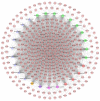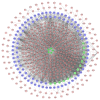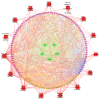A network pharmacology approach to investigate the pharmacological effects of Guizhi Fuling Wan on uterine fibroids
- PMID: 29201170
- PMCID: PMC5704263
- DOI: 10.3892/etm.2017.5170
A network pharmacology approach to investigate the pharmacological effects of Guizhi Fuling Wan on uterine fibroids
Abstract
To investigate the pharmacological mechanism of Guizhi Fuling Wan (GFW) in the treatment of uterine fibroids, a network pharmacology approach was used. Information on GFW compounds was collected from traditional Chinese medicine (TCM) databases, and input into PharmMapper to identify the compound targets. Genes associated with uterine fibroids genes were then obtained from the GeneCards and Online Mendelian Inheritance in Man databases. The interaction data of the targets and other human proteins was also collected from the STRING and IntAct databases. The target data were input into the Database for Annotation, Visualization and Integrated Discovery for gene ontology (GO) and pathway enrichment analyses. Networks of the above information were constructed and analyzed using Cytoscape. The following networks were compiled: A compound-compound target network of GFW; a herb-compound target-uterine fibroids target network of GWF; and a compound target-uterine fibroids target-other human proteins protein-protein interaction network, which were subjected to GO and pathway enrichment analyses. According to this approach, a number of novel signaling pathways and biological processes underlying the effects of GFW on uterine fibroids were identified, including the negative regulation of smooth muscle cell proliferation, apoptosis, and the Ras, wingless-type, epidermal growth factor and insulin-like growth factor-1 signaling pathways. This network pharmacology approach may aid the systematical study of herbal formulae and make TCM drug discovery more predictable.
Keywords: Guizhi Fuling Wan; formula; mechanism; network pharmacology; uterine fibroids.
Figures







Similar articles
-
Randomized double-blind trial comparing low dose and conventional dose of a modified traditional herbal formula Guizhi Fuling Wan in women with symptomatic uterine fibroids.J Ethnopharmacol. 2022 Jan 30;283:114676. doi: 10.1016/j.jep.2021.114676. Epub 2021 Sep 22. J Ethnopharmacol. 2022. PMID: 34562564 Clinical Trial.
-
Potential Mechanisms of Guizhi Fuling Wan in Treating Endometriosis: An Analysis Based on TCMSP and DisGeNET Databases.J Ethnopharmacol. 2024 Jul 15;329:118190. doi: 10.1016/j.jep.2024.118190. Epub 2024 Apr 16. J Ethnopharmacol. 2024. PMID: 38614264 Review.
-
Network pharmacology evaluation of the active ingredients and potential targets of XiaoLuoWan for application to uterine fibroids.Biosci Rep. 2020 Dec 23;40(12):BSR20202342. doi: 10.1042/BSR20202342. Biosci Rep. 2020. PMID: 33196098 Free PMC article.
-
Guizhi Fuling Wan for uterine fibroids: A systematic review of in vivo studies.J Ethnopharmacol. 2019 Dec 5;245:112177. doi: 10.1016/j.jep.2019.112177. Epub 2019 Aug 21. J Ethnopharmacol. 2019. PMID: 31445128
-
The crucial component(s) of Guizhi Fuling Wan in inhibiting endometriosis development.J Ethnopharmacol. 2025 Feb 10;338(Pt 2):119067. doi: 10.1016/j.jep.2024.119067. Epub 2024 Nov 8. J Ethnopharmacol. 2025. PMID: 39522847
Cited by
-
Therapeutic Targets of Bufalin on Renal Carcinoma and Mechanisms: Experimental Validation of Network Pharmacology Analysis.Evid Based Complement Alternat Med. 2022 Jan 28;2022:5469795. doi: 10.1155/2022/5469795. eCollection 2022. Evid Based Complement Alternat Med. 2022. PMID: 35126601 Free PMC article.
-
Elucidation of the Mechanisms and Molecular Targets of Yiqi Shexue Formula for Treatment of Primary Immune Thrombocytopenia Based on Network Pharmacology.Front Pharmacol. 2019 Oct 1;10:1136. doi: 10.3389/fphar.2019.01136. eCollection 2019. Front Pharmacol. 2019. PMID: 31632275 Free PMC article.
-
Anti-Angiogenic Alternative and Complementary Medicines for the Treatment of Endometriosis: A Review of Potential Molecular Mechanisms.Evid Based Complement Alternat Med. 2018 Oct 1;2018:4128984. doi: 10.1155/2018/4128984. eCollection 2018. Evid Based Complement Alternat Med. 2018. PMID: 30402122 Free PMC article. Review.
-
Unraveling the Antioxidant Capacity of Spatholobi caulis in Nonalcoholic Fatty Liver Disease: A Multiscale Network Approach Integrated with Experimental Validation.Antioxidants (Basel). 2023 May 13;12(5):1097. doi: 10.3390/antiox12051097. Antioxidants (Basel). 2023. PMID: 37237962 Free PMC article.
-
Reverse Screening Methods to Search for the Protein Targets of Chemopreventive Compounds.Front Chem. 2018 May 9;6:138. doi: 10.3389/fchem.2018.00138. eCollection 2018. Front Chem. 2018. PMID: 29868550 Free PMC article. Review.
References
LinkOut - more resources
Full Text Sources
Other Literature Sources
